Gasdermin E permits interleukin-1 beta release in distinct sublytic and pyroptotic phases
- PMID: 33852854
- PMCID: PMC8106763
- DOI: 10.1016/j.celrep.2021.108998
Gasdermin E permits interleukin-1 beta release in distinct sublytic and pyroptotic phases
Abstract
Cellular inflammasome activation causes caspase-1 cleavage of the pore-forming protein gasdermin D (GSDMD) with subsequent pyroptotic cell death and cytokine release. Here, we clarify the ambiguous role of the related family member gasdermin E (GSDME) in this process. Inflammasome stimulation in GSDMD-deficient cells led to apoptotic caspase cleavage of GSDME. Endogenous GSDME activation permitted sublytic, continuous interleukin-1β (IL-1β) release and membrane leakage, even in GSDMD-sufficient cells, whereas ectopic expression led to pyroptosis with GSDME oligomerization and complete liberation of IL-1β akin to GSDMD pyroptosis. We find that NLRP3 and NLRP1 inflammasomes ultimately rely concurrently on both gasdermins for IL-1β processing and release separately from their ability to induce cell lysis. Our study thus identifies GSDME as a conduit for IL-1β release independent of its ability to cause cell death.
Keywords: GSDMD; GSDME; IL-1; cell death; gasdermin D; gasdermin E; gasdermins; inflammasome; interleukin-1; pore-forming proteins.
Copyright © 2021 The Author(s). Published by Elsevier Inc. All rights reserved.
Conflict of interest statement
Declaration of interests The authors declare no competing interests.
Figures
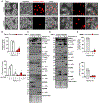
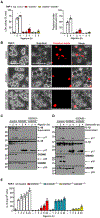
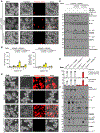
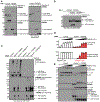
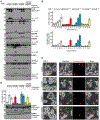
Similar articles
-
NLRP3 inflammasome activation triggers gasdermin D-independent inflammation.Sci Immunol. 2021 Oct 22;6(64):eabj3859. doi: 10.1126/sciimmunol.abj3859. Epub 2021 Oct 22. Sci Immunol. 2021. PMID: 34678046 Free PMC article.
-
Emerging insights into molecular mechanisms underlying pyroptosis and functions of inflammasomes in diseases.J Cell Physiol. 2020 Apr;235(4):3207-3221. doi: 10.1002/jcp.29268. Epub 2019 Oct 17. J Cell Physiol. 2020. PMID: 31621910 Review.
-
Mechanism and Regulation of NLRP3 Inflammasome Activation.Trends Biochem Sci. 2016 Dec;41(12):1012-1021. doi: 10.1016/j.tibs.2016.09.002. Epub 2016 Sep 23. Trends Biochem Sci. 2016. PMID: 27669650 Free PMC article. Review.
-
Inflammasome-dependent Mechanisms Involved in Sensing and Restriction of Bacterial Replication.Curr Issues Mol Biol. 2018;25:99-132. doi: 10.21775/cimb.025.099. Epub 2017 Sep 6. Curr Issues Mol Biol. 2018. PMID: 28875942 Review.
-
Suppression of the caspase-1/GSDMD-mediated pyroptotic signaling pathway through dexamethasone alleviates corneal alkali injuries.Exp Eye Res. 2022 Jan;214:108858. doi: 10.1016/j.exer.2021.108858. Epub 2021 Nov 23. Exp Eye Res. 2022. PMID: 34822855
Cited by
-
Raptinal Induces Gasdermin E-Dependent Pyroptosis in Naïve and Therapy-Resistant Melanoma.Mol Cancer Res. 2022 Dec 2;20(12):1811-1821. doi: 10.1158/1541-7786.MCR-22-0040. Mol Cancer Res. 2022. PMID: 36044013 Free PMC article.
-
Nanomaterial-induced pyroptosis: a cell type-specific perspective.Front Cell Dev Biol. 2024 Jan 9;11:1322305. doi: 10.3389/fcell.2023.1322305. eCollection 2023. Front Cell Dev Biol. 2024. PMID: 38264354 Free PMC article. Review.
-
Balance Cell Apoptosis and Pyroptosis of Caspase-3-Activating Chemotherapy for Better Antitumor Therapy.Cancers (Basel). 2022 Dec 21;15(1):26. doi: 10.3390/cancers15010026. Cancers (Basel). 2022. PMID: 36612023 Free PMC article. Review.
-
Regulation of gasdermins in pyroptosis and cytokine release.Adv Immunol. 2023;158:75-106. doi: 10.1016/bs.ai.2023.03.002. Epub 2023 Apr 11. Adv Immunol. 2023. PMID: 37453754 Free PMC article.
-
Pyroptosis in health and disease.Am J Physiol Cell Physiol. 2024 Mar 1;326(3):C784-C794. doi: 10.1152/ajpcell.00503.2023. Epub 2024 Jan 8. Am J Physiol Cell Physiol. 2024. PMID: 38189134 Free PMC article. Review.
References
-
- Broz P, Pelegrín P, and Shao F (2020). The gasdermins, a protein family executing cell death and inflammation. Nat. Rev. Immunol 20, 143–157. - PubMed
Publication types
MeSH terms
Substances
Grants and funding
LinkOut - more resources
Full Text Sources
Other Literature Sources
Molecular Biology Databases

